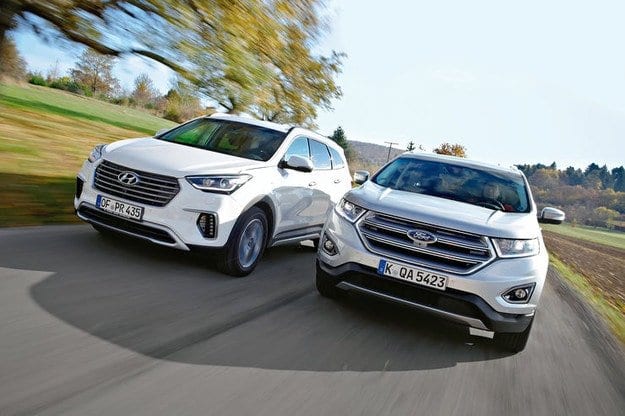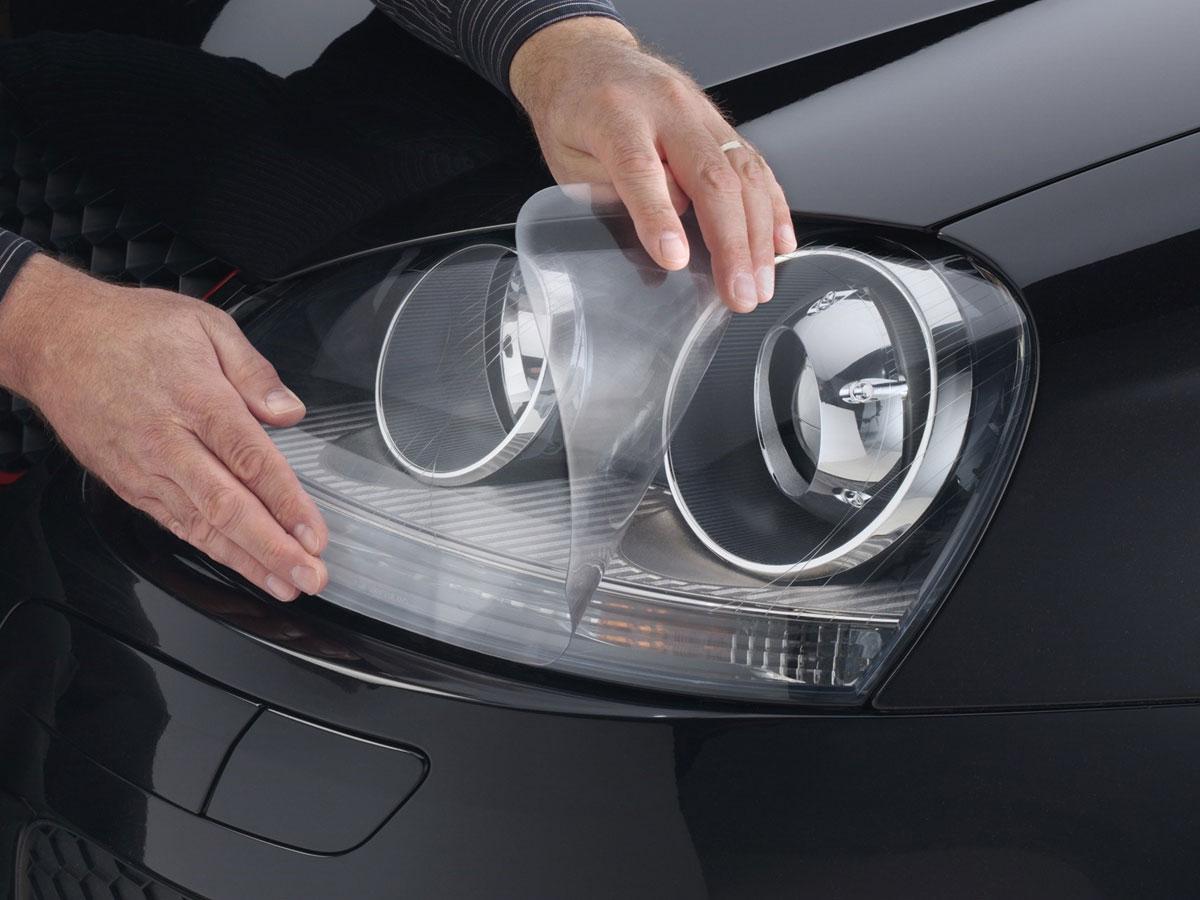
Test drive Ford Edge 2.0 TDCI vs Hyundai Grand Santa Fe 2.2 CRDI
Content

Test of two models of mid-range SUVs - guests from America
The Ford Edge 2.0 TDCi and Hyundai Grand Santa Fe 2.2 CRDi 4WD offer around 200 diesel horsepower, dual transmission and automatic transmission for nearly €50. But which of the two cars is better - a compact Ford or a comfortable Hyundai?
One of the many unsolved mysteries in the automotive business is why Japanese manufacturers are almost without a fight conceding to European - mostly German - competitors the lucrative field of mid-range and high-end SUV models. In addition, all have suitable models in the US market - we can note the Toyota 4Runner, Nissan Pathfinder or Mazda CX-9. Ford and Hyundai didn't capture much and sold the Edge and Santa Fe, also designed for the US market, in Europe. With powerful diesels and a standard dual transmission, both cars are quite good in the price range around 50 euros. This is true?
Prices in Germany start at almost 50 euros.
Let's look at the price lists, which in both models do not contain an unknown number of options to choose from. For example, the Ford Edge is only available in Germany with a 180 hp 210-litre diesel. in the version with manual transmission and 41 hp. with Powershift (dual clutch transmission), both options come with Titanium and ST-Line equipment respectively. The cheapest is the low-equipped Trend level with mechanical shifting (from 900 euros), the Titanium with an automatic costs at least 45 euros.
The comparable long version of the Hyundai model only comes with a 200 hp diesel engine. and with a six-speed automatic for 47 euros. Even cheaper is the shorter Santa Fe with almost 900 cm (without the Grand), which with 21 hp, dual gearbox and automatic transmission costs 200 euros less. In the US, by the way, the little Santa Fe is called Sport, and the big one doesn't have the Grand addition.
The compact Edge offers surprisingly much space
In this case, the name Grand should really be taken literally. But even though it is only a few centimeters long and reaches five meters in length, that doesn't give it any real space advantage over the more compact Edge. The luggage racks are practically the same size, and the Hyundai cabin doesn't look any more spacious than the also fairly spacious Ford. Only if you need to transport more than five people, everything speaks in favor of the Santa Fe, because the Edge is not available in the seven-seat version, even at an additional cost.
The fact that placement and placement in the third row can be recommended, rather, to children, can only be mentioned for the sake of completeness. Having settled down in both models of SUVs much better, you feel, of course, sitting on standard seats. They benefit, among other things, from a so-called pleasantly high hip point; the buttocks in both cases rise about 70 centimeters above the road surface - as we know, for many already very young customers this is one of the good reasons to buy an SUV. For comparison: with Mercedes E-Class or VW Passat passengers sit about 20 cm lower.
And since we are already talking about the advantages, we do not intend to ignore the disadvantages inherent in this type of design. In terms of ride comfort, both cars fall short of the qualities of good mid-range sedans. First, the Ford model behaves a little rough, tapping bumps relatively rough and doesn't help with chassis noise. The 19-inch wheels, which were fitted with 5/235 Continental Sport Contact 55 tires on the test car, don't help much either. The Santa Fe comes standard with 18-inch alloy wheels and Hankook Ventus Prime 2 tires. It's true that with the softer settings, it moves more smoothly on secondary roads, but this comes with more pronounced body movements. – a feature that not everyone will like. Because the Edge is also furnished with more comfortable furniture, it wins, albeit by a hair's breadth, in the area of comfort.
Hyundai has a slightly smoother and quieter diesel engine. The Ford four-cylinder feels a little rougher and more intrusive in terms of acoustics, but otherwise it's the best engine in this comparison. Firstly, in terms of fuel consumption, the 1,1-liter bi-turbo engine takes the lead, consuming an average of 100 liters less per 50 km in the test - this is an argument even for cars of the 000 euro class.
And while on paper its dynamic performance is better than just 130 km / h, on the road it feels more impulsive than the phlegmatic Hyundai. Last but not least, the transmission: The Powershift Edge transmission responds faster, shifts more responsively and provides a more modern driving experience than the clunky six-speed torque converter automatic transmission in the Grand Santa Fe.
Ford Edge is cheaper to maintain
The Ford model behaves much more agile and agile around corners. Its body has less tendency to wobble, the steering is more straightforward and with more road feel, and the dual drivetrain seems to respond more quickly to clutch problems.
In fact, both SUVs are based on front-wheel drive vehicles, with the Edge transferring some of the drivetrain to the rear axle via a Haldex clutch. Santa Fe has a slatted clutch designed in collaboration with Magna. If necessary, a maximum of 50 percent of the torque can be transferred backwards, which of course also has advantages when towing heavy trailers. True, for a large SUV, the 2000 kg model is not considered something special, but with a maximum weight of 2500 kg, both cars belong to the light category among large SUVs. A factory trailer tow hook can only be ordered for Ford (mobile, € 750) and Hyundai dealers offer retrofit options.
The maintenance costs of the Ford model are lower, but the price of the Grand Santa Fe is lower. Even in the simpler Style version, the Hyundai spokesperson has leather upholstery as standard, a luxury that costs an extra 1950 euros in the Edge Titanium. Hyundai's five-year warranty also has a positive effect on price sales, while the Edge's warranty does not exceed the usual two years. At home, Ford is not so tough - a five-year warranty on the transmission. Although something in America is better.
Text: Heinrich Lingner
Photo: Rosen Gargolov
Evaluation
Ford Edge 2.0 TDCi Bi-Turbo 4 × 4 Titan
With agility, an economical yet punchy engine and good interior, the Ford Edge wins this test. There are comments on the control of functions.
Hyundai Grand Santa Fe 2.2 CRDi 4WD Style
The comfortable Hyundai Grand Santa Fe copes better with team actions, but loses points due to the greedy motorcycle and phlegmatic behavior on the road.
technical details
| Ford Edge 2.0 TDCi Bi-Turbo 4 × 4 Titan | Hyundai Grand Santa Fe 2.2 CRDi 4WD Style | |
|---|---|---|
| Working volume | 1997 cc | 2199 cc |
| Power | 210 k.s. (154 kW) at 3750 rpm | 200 k.s. (147 kW) at 3800 rpm |
| Maximum torque | 450 Nm at 2000 rpm | 440 Nm at 1750 rpm |
| Acceleration 0-100 km / h | 9,4 with | 9,3 with |
| Braking distances at a speed of 100 km / h | 36,6 m | 38,3 m |
| full speed | 211 km / h | 201 km / h |
| Average consumption fuel in the test | 8,5 l / 100 km | 9,6 l / 100 km |
| Base Price | 49.150 € (in Germany) | 47.900 € (in Germany) |

